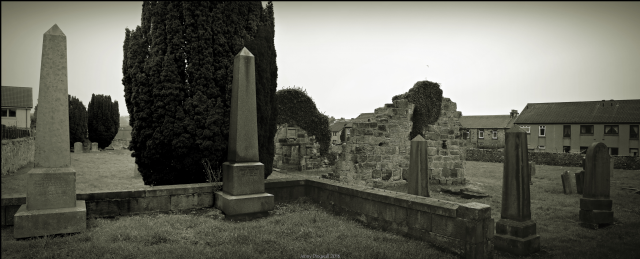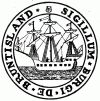
The Young Burial Enclosure

The Early Years
The Youngs seem to have been based in the Parish of Orwell (now Milnathort), Kinross-shire, until about 1786. William Young #1 was in Orwell when he married his second wife in 1784, and their first child Thomas was born in Orwell in October 1785. The Grange Brewery of Messrs Boog & Thomson was established in 1767 and was converted to a distillery in 1786; and as a distillery it was owned by the Youngs. The Youngs were certainly in Burntisland by October 1786, when their second child William was born. Putting two and two together, it's a reasonable hypothesis that William Young and his second wife decided to embark on a new life in Burntisland around 178586, bought or leased Grange Farm and House (probably from the Aytouns), acquired the brewery and converted the brewery to a distillery. Sons George and Thomas moved to Leith, where they appear to have established (in partnership) the firm of merchants, George Young & Co. William Young #2 remained at Grange House and was perhaps the most significant figure in the running of the distillery. This branch of the family also built up a significant portfolio of farm properties (some or all of which they may have leased). The lands in which they had an interest when John Young #2 died in 1858 were:
- Grange
- Walton
- Newbigging
- Glasliehead (sic)
- Dunearn
- Silverbarton
- Lochies Bennet
- Lonsdale
In 1858, this branch of the family occupied Grange House and Newbigging House.
Landed Gentry
William Young #2 was living at Newbigging in 1851. He died at Grange House in 1855, aged 69 - a good age in those days. His sons were less fortunate. His eldest son, William, died in 1854 - a year before his father and aged only 33 (cause of death unknown). His second son, John, was killed aged 26 in an accident at Grange when a gig overturned. His third son, Joseph, suffered from poor health and moved to Folkestone to benefit from the kinder climate. He died there in 1864, aged 41. John and Joseph were both millionaires (in today's terms) when they died. The major share of the estate of this branch of the family passed to the children of Thomas Young of Leith (with the balance to the Purvises?). It is likely that Thomas's male children, William Simson and David, were closely involved in the management of the distillery because they are both recorded as staying at Grange House after the death of Joseph. William Simson Young's association would have been a short one, as he died at Grange House in 1865, aged 42. David may well have carried on the business for many years, and he is recorded as staying at Earn Craig (probably the building we refer to as the Royal Hotel, and which is now Briggs's head office) in 1867 and 1871. William Young & Co (the trading name for the distillery) became a limited company in 1888, and in 1914 it joined four other distillery companies to form Scottish Malt Distillers Ltd. Production at Grange ceased in 1927.
Sons John and Robert were based at Colinswell, and Robert's farming activities were separate from those of his brother William. However, both John and Robert had a share in the distillery. John's pre-nuptial agreement ensured that when he died his share in the distillery remained in the hands of the Youngs.
With Robert, it may be that the absence of an heir persuaded him to take the plunge at the age of 67 and marry Anne, the 24 year old niece of the Rev Thomas Chalmers, founder of the Free Church of Scotland. Robert was 73 when his third and last child was born.
Robert's will dated 1855 lists his substantial land and property holdings, all of which he appears to have owned outright. They included:
- Colinswell Park and House
- Gedemiln (probably Ged's Mill)
- Craigholm (see below)
- Binend (sic)
- Whinnyhall (sic)
- Common
- Rodanbrae
- Kinghorn Loch and Lochlands
- Craigencat (sic)
- Gallahill
The Later Years
The will established a Trust to manage the estate, with the bulk of it to pass to his son Robert William when he reached the age of 25. Robert senior was seriously rich - his estate amounted to about £3m in today's terms, and that did not include his land and property holdings.
His will makes it clear that he was a hard liner when it came to the Roman Catholic faith. If his daughters became Catholics, or married Catholics, they would have their inheritances significantly reduced. Similarly, if any of his executors became Catholics, they would be disqualified from acting.
A 1901 map shows lands at Colinswell and Meadowfield as belonging to Robert Young - probably Robert William Young.
Two of William Young #1's daughters, Helen and Betsy (known as the Misses Young), set up home in Burntisland town centre. They are recorded at the Shore in the 1841 and 1851 censuses. The property at the Shore is probably the one which is now Briggs's head office. Helen died at Young's Place (again probably the Briggs building) in 1862, aged 74. Betsy died at an unspecified address in the High Street in 1865, aged 73 - probably at what is now the Bank House Hotel, a substantial town house which belonged to the Youngs.
Benefactors to the Town
- The family were entrepreneurs, farmers, distillers and benefactors. They appear to have been well respected and to have been closely involved in many aspects of community life. Most of the Burntisland-based male members of the family described themselves as distillers, rather than farmers, and it may well be that the distillery was the main source of their wealth.
- William Young #2 served as Provost of Burntisland from 1831 to 1834, and again from 1848 to 1851.
- Young's Wynd (now Lothian Street) was named after the family, apparently as a result of their widening it to permit easier passage for their livestock when being driven to the harbour. Young's Place (now part of Seaforth Place) was probably also named after them.
- The family left a rich heritage of buildings. The following list is very much a provisional one:
- Grange House (although dating from 1680, was subsequently greatly altered and extended)
- Grange Distillery buildings (built c1805, partly demolished)
- Dunearn House? (NB - although the family held the lands of Dunearn, there is no mention of the house in any of the documents which have been examined.)
- Newbigging (House) (built 1825)
- Colinswell House
- Possibly other farmhouses and buildings.
- Town house at the Shore (now Briggs's head office) (built 1807)
- Town house in the High Street (now the Bank House Hotel) (built c1800)
- The first Free Church and School (built c1844, now demolished)
- The Music Hall
- The family were benefactors, donating the following (not a comprehensive list):
- The first Free Church and Schoolxviii
- The Music Hallxix
- Money for poor relief in the Parish
- Robert Young provided a home in Burntisland for the Rev Thomas Chalmers.


